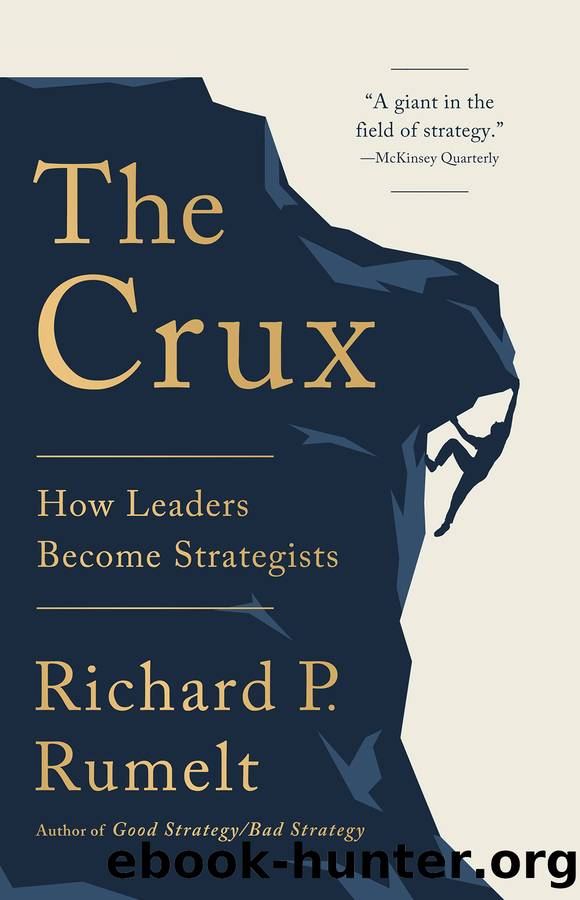The Crux by Richard P. Rumelt

Author:Richard P. Rumelt [P., Richard Rumelt]
Language: eng
Format: epub
Publisher: PublicAffairs
Published: 2022-05-03T00:00:00+00:00
In sum, follow-on research has not supported the Christensen story of companies being too focused on main customers and missing the rise of low-performance, low-price disruptors. Since we do see powerful firms occasionally pushed aside by smaller rivals or newcomers, or new technology, what is happening? Some insight can be gained by looking at a few dramatic examples of real disruption.
The decline of Kodak is often used as a warning about the fate of those who ignore the warning signals of disruptive forces. But there was no low-cost, low-performance âproductâ disrupting it. What would you have done had you owned Kodak? It made 70 percent gross margins on a large, slowly declining film business. It wisely sold off its intellectual property in chemicals and actually built a digital camera nearly fifty years ago, in 1975. Its executives knew digital was coming, but they imagined a world where digital photos would be printed and put in albums or hung proudly on the wall. So they invested in digital photo storage and fine printing. In 2000 could you or they foresee people sharing low-resolution selfies on their small screen phones? If you were to invest millions or billions in digital, in what device or system or product? Cameras? Printers? CDs? Personal computers? Screens? Photo-processing software? Phones? Kodak was disrupted, but not by a competitor. It was disrupted by an entire ecosystem.
Kodakâs demise is also mirrored in the downfall of the Encyclopedia Britannica, done in by computers and the Web. For several generations, the Encyclopedia Britannica was sold, often door-to-door, to parents as an investment in the education of their children. The price was thousands of dollars and normally included a handsome bookcase to house the thirty-two volumes. In print for more than two hundred years, it was written by more than four thousand separate contributors and edited by a staff of about a hundred.
It offered a CD-ROM version, but sales did not compensate for the loss of hard-bound book placements. It tried an online subscription version, with little uptake at its prices. It wasnât Wikipedia, or Encarta, or Scholarpedia, or Digital Universe, or tablets, or phones that âdisruptedâ Britannica. It was the entire ecosystem of personal computers, phones, the Web, Google, bloggers, Google Books, and more. As with Kodak, there was no one product to counter, no clear competitor to parry, no acquisition that could save the day.
How to Deal with Disruption?
The real challenge of âdisruptionâ is not that you donât see it coming. The real challenges are:
(A) that it costs more profit to respond than it seems to be worth
(B) that your organization lacks the necessary technical ability, financial strength, or organizational skills to respond
(C) that it is the destruction of the whole ecosystem in which you live
If you do not face any of these three sharp challenges, then you do not really have a disruption problem. You have a fairly standard strategy problem. For example, in 1980 the rise in oil prices had damaged Monsantoâs large asset-heavy petrochemicals business. Still,
Download
This site does not store any files on its server. We only index and link to content provided by other sites. Please contact the content providers to delete copyright contents if any and email us, we'll remove relevant links or contents immediately.
Hit Refresh by Satya Nadella(9040)
The Compound Effect by Darren Hardy(8817)
Change Your Questions, Change Your Life by Marilee Adams(7638)
Nudge - Improving Decisions about Health, Wealth, and Happiness by Thaler Sunstein(7622)
The Black Swan by Nassim Nicholas Taleb(7016)
Deep Work by Cal Newport(6886)
Daring Greatly by Brene Brown(6449)
Rich Dad Poor Dad by Robert T. Kiyosaki(6413)
Principles: Life and Work by Ray Dalio(6223)
Playing to Win_ How Strategy Really Works by A.G. Lafley & Roger L. Martin(5934)
Man-made Catastrophes and Risk Information Concealment by Dmitry Chernov & Didier Sornette(5925)
Digital Minimalism by Cal Newport;(5667)
Big Magic: Creative Living Beyond Fear by Elizabeth Gilbert(5616)
The Myth of the Strong Leader by Archie Brown(5429)
The Slight Edge by Jeff Olson(5353)
Discipline Equals Freedom by Jocko Willink(5288)
The Motivation Myth by Jeff Haden(5158)
Stone's Rules by Roger Stone(5027)
The Laws of Human Nature by Robert Greene(5002)
